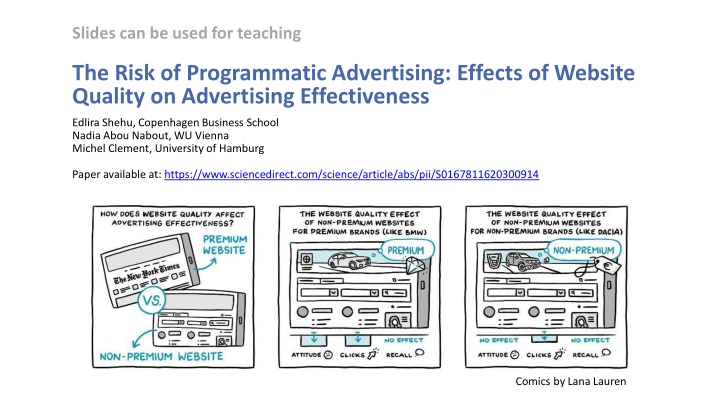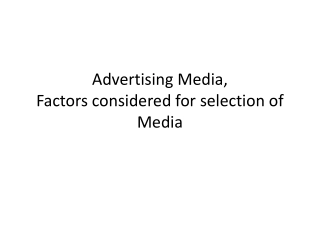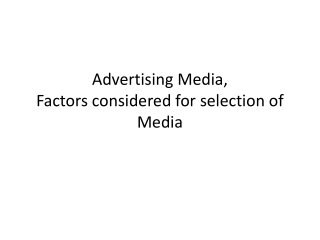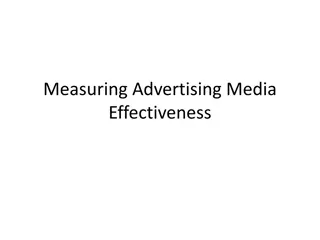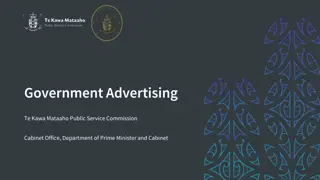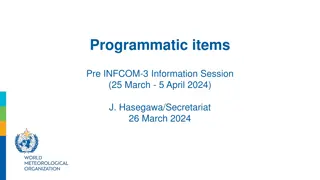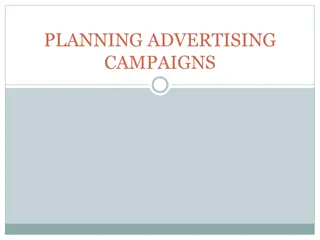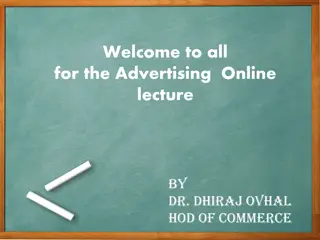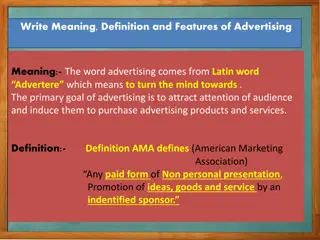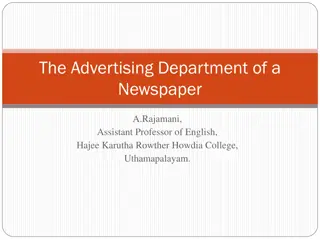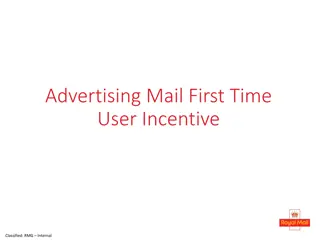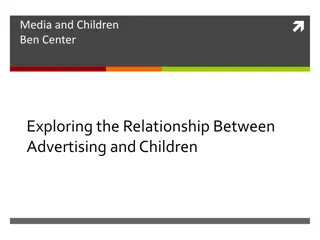Programmatic Advertising: Impact of Website Quality on Ad Effectiveness
Explore the use of slides for teaching the risks and effects of programmatic advertising based on website quality. Identify premium vs. nonpremium websites, campaign strategies, and goals for branding and performance. Improve decision-making by categorizing website quality and targeting campaigns effectively.
Download Presentation

Please find below an Image/Link to download the presentation.
The content on the website is provided AS IS for your information and personal use only. It may not be sold, licensed, or shared on other websites without obtaining consent from the author.If you encounter any issues during the download, it is possible that the publisher has removed the file from their server.
You are allowed to download the files provided on this website for personal or commercial use, subject to the condition that they are used lawfully. All files are the property of their respective owners.
The content on the website is provided AS IS for your information and personal use only. It may not be sold, licensed, or shared on other websites without obtaining consent from the author.
E N D
Presentation Transcript
Slides can be used for teaching The Risk of Programmatic Advertising: Effects of Website Quality on Advertising Effectiveness Edlira Shehu, Copenhagen Business School Nadia Abou Nabout, WU Vienna Michel Clement, University of Hamburg Paper available at: https://www.sciencedirect.com/science/article/abs/pii/S0167811620300914 Comics by Lana Lauren
More than 60% of worldwide digital ad spend in 2019 ($333.25 billion) spent on programmatic advertising 2
Programmatic advertising gives marketers limited control over where ads appear 3
Advertisers differentiate between premium and nonpremium websites Premium websites: reputable publishers high-quality editorial content superior website design Nonpremium websites: user-generated content content aggregators gaming platforms user forums Examples: allrecipes.com lifehacker.com chegg.com tmz.com Examples: nytimes.com espn.com vogue.com nationalgeographic.com 4
Current practice relies on gut feeling: PREMIUM BRANDS advertise on premium websites Q1 Q2 Q3 Q4 Advertising strategy for: Branding campaign/ Premium brand Branding campaign/ Nonpremium brand Annual sales in EUR Perfor-mance goals Website quality Performance campaign/ Premium brand Position Branding goals Performance campaign/ Nonpremium brand Clicks, purchase 1) CEO > 29m Awareness, attitudes P vs NP P NP P NP Clicks, purchase 2) Media director > 26m Awareness, attitudes P vs NP P P NP NP 3) Digital venture capital investor Clicks, purchase Unknown Awareness, attitudes P vs NP P P NP NP 4) Head of online advertising >140m Awareness Clicks P vs NP P NP P* NP Awareness, video completion Clicks, purchase 5) Managing partner > 60m P vs NP P NP P NP Notes: P=premium, NP=nonpremium Question 1: Which goals do you pursue in case of branding campaigns? Question 2: Which goals do you pursue in case of performance campaigns? Question 3: What categorization do you use to differentiate between websites of different quality? Question 4: Where would you run the following campaigns (premium or nonpremium website)? Branding campaign of BMW Branding campaign of Dacia Performance campaign of BMW Performance campaign of Dacia 5 * If advertiser is willing to carry the additional costs.
Current practice relies on gut feeling: BRANDING CAMPAIGNS advertise on premium websites Q1 Q2 Q3 Q4 Advertising strategy for: Branding campaign/ Premium brand Branding campaign/ Nonpremium brand Annual sales in EUR Perfor-mance goals Website quality Performance campaign/ Premium brand Position Branding goals Performance campaign/ Nonpremium brand Clicks, purchase 1) CEO > 29m Awareness, attitudes P vs NP P NP P NP Clicks, purchase 2) Media director > 26m Awareness, attitudes P vs NP P P NP NP 3) Digital venture capital investor Clicks, purchase Unknown Awareness, attitudes P vs NP P P NP NP 4) Head of online advertising >140m Awareness Clicks P vs NP P NP P* NP Awareness, video completion Clicks, purchase 5) Managing partner > 60m P vs NP P NP P NP Notes: P=premium, NP=nonpremium Question 1: Which goals do you pursue in case of branding campaigns? Question 2: Which goals do you pursue in case of performance campaigns? Question 3: What categorization do you use to differentiate between websites of different quality? Question 4: Where would you run the following campaigns (premium or nonpremium website)? Branding campaign of BMW Branding campaign of Dacia Performance campaign of BMW Performance campaign of Dacia 6 * If advertiser is willing to carry the additional costs.
How does advertising on nonpremium websites affect advertising effectiveness? Study 1 Study 2 7
Study 1: Setting Global video sharing platform Definition of premium vs. non-premium channel provided by video sharing platform Panelists recruited from GfK Media Efficiency Panel Randomization of ads to 5,305 respondents (no targeting) 18 premium & non-premium brands Real search queries Potential self-selection bias of respondents assignment to premium/non-premium channels based on their real searching behavior 8
Dealing with potential self-selection bias Propensity-score matching (PSM) using nearest neighbor algorithm Variables included in PSM: sociodemographic characteristics (age, education, and household status) usage characteristics on the video platform during the month prior to our study (time spent online and on the video platform) interest in the advertised product category number of total video ad impressions before completing the survey Various robustness checks regarding the PSM can be found in the paper 9
We do NOT see significant effects on recall Recall 0.4 0.36 0.32 0.32 0.28 0.3 0.2 0.1 0 Premium brand Non-premium brand Premium channel Non-premium channel 10
We do see significant effects on attitudes Ad liking 3.8 3.7 3.7 p < .05 3.6 3.5 3.4 3.3 3.3 3.3 3.3 3.2 3.1 Premium brand Non-premium brand Premium channel Non-premium channel 11
We do see significant effects on attitudes Brand liking 3.8 3.7 3.7 p < .05 3.6 3.5 3.4 3.4 3.4 3.3 3.3 3.2 3.1 Premium brand Non-premium brand Premium channel Non-premium channel 12
Study 1: Summary Campaign goal: Brand awareness Context does not seem to matter! Campaign goal: Attitudes Premium brands: Ignoring website quality in brand advertising leads to lower attitudes Non-premium brands: Do not benefit from advertising on premium websites 13
Study 2 Data source: One of the largest ad exchanges in Europe Brands: 7 premium, 7 non-premium Banking, dating, fashion, lottery and betting, travel Websites: 41 premium, 43 non- premium Observation period: April 4 May 3, 2015 Delivered impressions: 379 million Real campaign data Potential endogeneity bias due to strategic advertiser behavior 14
Setting Variables of interest: Dependent variable: Ad performance: Number of clicks Control variables: Brand-level intercepts: Capture differences in media buying behavior across brands Impressions: Decision variable of the online marketer Banner format: 120 x 600: skyscraper, 160 x 600: wide skyscraper, 200 x 600: wide skyscraper alternative, 300 x 250: medium rectangle, 728 x 90: leaderboard Week + day-of-week fixed effects Independent variables: Website quality: Premium vs. non-premium Brand image: Premium vs. non-premium 15
Dealing with potential endogeneity Reverse causal effect of clicks on website quality as advertisers may decide to place their most promising ads on premium websites Control function approach 1. Step: Auxiliary probit model with website quality as dependent variable Instrument: For each brand, number of ads of all other brands displayed on premium websites on a specific day t excluding ads by the brand itself 2. Step: Include residuals from Step 1 in main model with number of clicks as dependent variable More details can be found in the paper 16
Effect of nonpremium websites on click behavior for PREMIUM brands 2.926 64% fewer clicks when on nonpremium websites 1.727 1.193 1.060 17
Effect of nonpremium websites on click behavior for NONPREMIUM brands 2.926 31% fewer clicks when on nonpremium websites 1.727 1.193 1.060 18
Study 2: Summary Campaign goal: Clicks & performance Context matters for both, premium and non-premium brands Negative effects are stronger for premium brands 19
Implications Premium brand Nonpremium brand Website quality relevant No programmatic Depending on strategy, some managers consider website quality relevant, others not Mixed use of programmatic* Website quality not relevant Programmatic Current industry practice Branding campaigns Website quality effects depend on campaign goal: Attitudes No programmatic Recall Programmatic Depending on strategy, some managers consider website quality relevant, others not Mixed use of programmatic* Website quality relevant Programmatic, only if cost advantage outweighs negative click effect Our advice based on empirical evidence Website quality not relevant Programmatic Current industry practice Performance campaigns Website quality relevant Programmatic, only if cost advantage outweighs negative click effect Our advice based on empirical evidence 20
Thank you If you have any questions regarding this material, you can contact us at nadia.abounabout@wu.ac.at Comics by Lana Lauren 21
